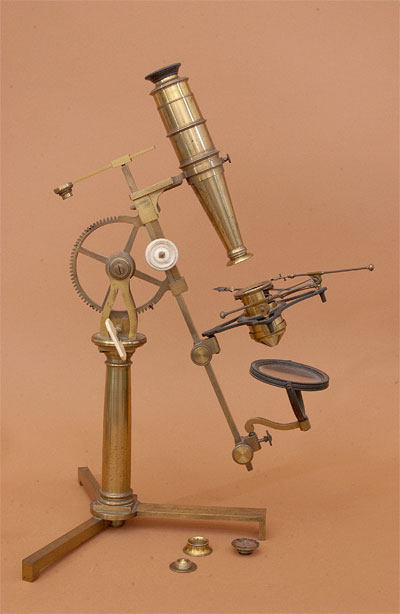 |
|||||
 |
 |
||||
 |
|||||
 |
 |
||||

This particular microscope has only one body tube with sliding draw tubes, although apparently some examples of this model were supplied with two body tubes. The optics normally used consist of the eye lens, the field lens, a Martin between-lens, and the objective lens. There are three sets of objectives supplied with this instrument. The microscope also has a simple magnifier assembly attached to the top of the support pillar. The stage attaches by a vertical pin to a sliding block on the limb. At each corner of the open stage is a hole for the various forceps ("nippers" as described by Adams) supplied with the instrument. The hole in the center of the stage receives a Bonanni spring stage which will accept slides or a glass tube. The large concave mirror attaches to the rectangular limb by means of a vertical pin in a sliding block. The block and the pin are movable and each has its own set screw. The mirror arm is an attractive scroll shape and holds the mirror at its end by a vertical hole in which the mirror may thus be moved in any direction. Imaging through both the compound microscope and simple magnifier is good, but exhibits chromatic and spherical aberration. The instrument can be stored in a large mahogany box.
George Adams, Sr. (1704–1773), a self-taught artisan in London, who established his shop on Fleet Street at the sign of Tycho Brahe's Head. Over a number of decades George Adams and Son produced quality instruments, including microscopes, as well as a number of books on microscopy. In 1746 he published the first of four editions of his book Micrographia Illustrata, a popular work which showcased the new models of his own production. He also included descriptions of methods for measuring the magnifying power of his microscopes. Adams Senior made several instruments for King George III, including an instrument called "The Prince of Wales microscope" (sometime between 1751 and 1760) and the famous ornate Silver Microscope created in 1761. When George senior died, his son (also George Adams, 1750–1795) took on the family business. George Jr. continued to make instruments, and improve microscopes. He was a more prolific writer than his father and produced a large number of works regarding instrumentation, including a series called Essays on the Microscope (1787). The Golub Collection has two microscopes (No. 6 & No. 17) created by Adams Jr. After George Jr. died his younger brother Dudley Adams continued the firm at 60 Fleet Street until the 1830s.
This microscope is certainly one of the more famous of the early microscopes. It is featured on the cover of Clay and Court (1932) and is Dr. Golub's signature microscope.
Featured 09/2011, 06/2022